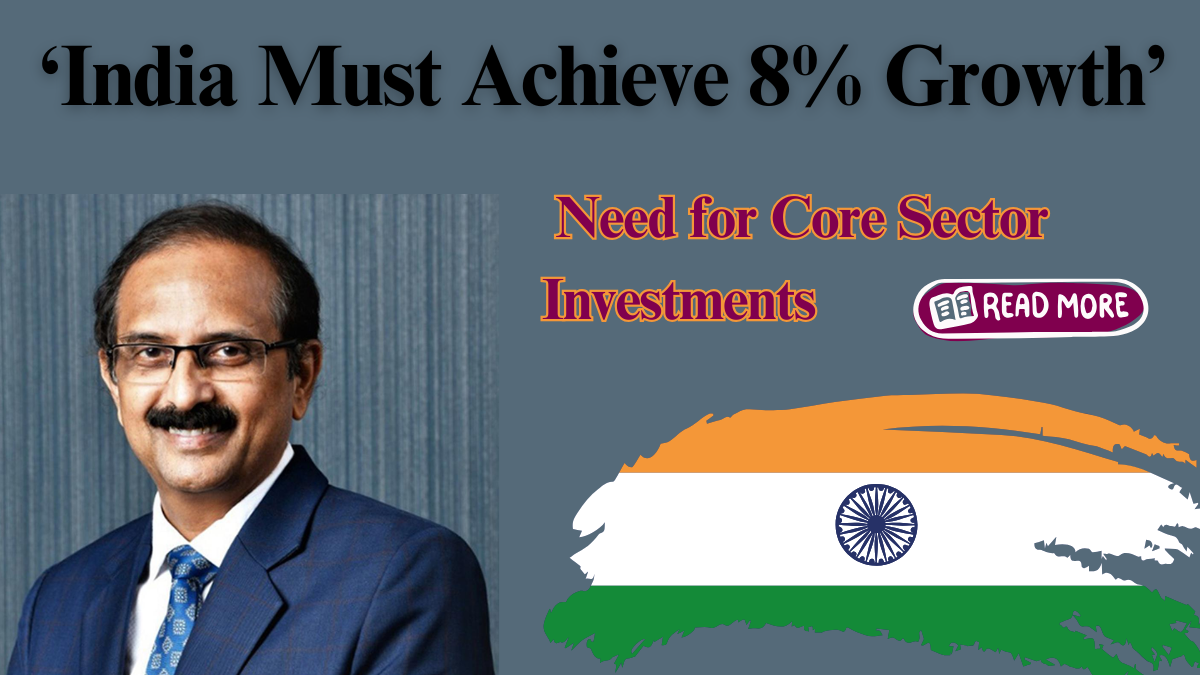India’s economic growth has been impressive in recent years, but achieving long-term, sustainable progress requires maintaining an 8% annual growth rate. According to the Chairman of the State Bank of India (SBI), this growth target can be met if the country addresses one critical aspect: investment in core sectors, such as steel, cement, infrastructure, and energy. While there has been substantial private capital expenditure in some sectors, the backbone of India’s economy—the core industries—has not seen the same level of investment. These sectors, which form the foundation for manufacturing, construction, and infrastructure, must step up their investments to ensure India can sustain growth and meet future demands.

Importance of Core Sectors in India’s Economic Growth
India’s core sectors are key to driving the nation’s economic engine forward. Sectors such as steel and cement are vital for building infrastructure and supporting the manufacturing industries. Without adequate investment in these sectors, the supply of essential materials for infrastructure projects would be strained, leading to increased costs and delays. Furthermore, as demand continues to rise, especially with the government’s ambitious plans for infrastructure development, these sectors must expand their capacity to keep up.
The SBI Chairman pointed out that these sectors have reached their capacity utilization limits, with industries like steel and cement already operating at around 75-76% of their potential. While this is an achievement in itself, it also means that without further investments, these sectors will struggle to meet the growing demand. A lack of investment could result in stagnation, limiting the potential for growth in the economy.
The Role of Private and Government Investments
To sustain growth at 8% per year, both the private sector and the government need to focus on these core sectors. Private capital expenditure has been increasingly directed towards certain industries, including technology, consumer goods, and services. However, it is the core sectors—such as steel, cement, and infrastructure—that require immediate attention and a boost in investment. If these industries do not receive the necessary funding, they will be unable to meet demand, which will ultimately hinder overall economic growth.
The government has an essential role to play in stimulating investment in the core sectors. It can provide tax incentives, subsidies, and create policies that encourage the private sector to direct funds towards these industries. Additionally, ensuring a favorable investment climate and reducing bureaucratic hurdles can make the process easier and more attractive for investors.
The Need for Long-Term Investment in Infrastructure
Infrastructure development is a key pillar of India’s growth strategy. The government’s National Infrastructure Pipeline (NIP) aims to provide more than Rs. 100 lakh crore in investments for infrastructure projects over the next few years. However, the success of these projects depends on the availability of the raw materials required to build them. If core sectors such as steel and cement do not increase their production capacity, infrastructure projects may face significant delays, pushing up costs and affecting the timely delivery of critical assets like roads, bridges, and affordable housing.
Moreover, a lack of capacity expansion in these sectors could also hurt India’s competitiveness on the global stage. Global supply chains rely on timely delivery and competitive pricing of materials like steel and cement. If India fails to meet this demand, it could lose its position as a major player in the global economy.
Economic Diversification and Technological Advancement
Beyond just increasing capacity, the core sectors also need to embrace new technologies and modernize their operations. Technological advancements can help improve efficiency, reduce costs, and increase production rates. For example, the steel and cement industries can benefit from automation and advanced manufacturing techniques that increase output and reduce wastage.
The Indian government’s push for a digital and technological revolution, including the promotion of AI, automation, and smart cities, also ties into this need for modernization in the core sectors. As the country moves towards these technological advancements, it is important that the core sectors align with this vision to ensure that they can support the rapid development of a digital economy.
Challenges and Roadblocks
While the need for investment in core sectors is clear, several challenges hinder the flow of capital into these industries. High upfront costs and long payback periods can deter private investors. Moreover, core sectors like steel and cement often face fluctuating raw material prices, which can make it difficult to predict costs and returns accurately. Environmental concerns also play a significant role in investment decisions, as many of these sectors are energy-intensive and produce significant emissions.
Government policies will need to address these challenges by creating a more attractive environment for investors. Ensuring that environmental standards are met while promoting investment can be a delicate balancing act, but with the right policy interventions, it is certainly achievable.
What Needs to be Done
The 8% growth target for India is achievable, but it requires an integrated approach. Investment in core sectors must be ramped up to ensure that these industries can meet the demands of a growing economy. This will require a multi-faceted approach that includes public-private partnerships, government incentives, and technological innovation.
Furthermore, the Indian government needs to continue its focus on improving the ease of doing business, particularly in sectors like steel and cement. By creating an investment-friendly environment, the country can attract both domestic and international investments into these critical industries. Modernization and capacity expansion, combined with a favorable policy landscape, will position India on a strong trajectory toward sustainable economic growth.
Conclusion
India’s goal of maintaining an 8% growth rate hinges on addressing the capacity limitations in its core sectors. With private capital already flowing into various industries, it is time for the core sectors, including steel, cement, and infrastructure, to receive the same level of investment. Investment in these areas will not only meet the growing demand for resources but also support the government’s infrastructure goals. With the right policy support, technological innovation, and increased capital expenditure, India can overcome the challenges and set itself on the path to achieving its growth aspirations.
FAQ
Why is 8% growth essential for India?
An 8% growth rate is vital to support the growing population, meet infrastructure needs, and sustain long-term economic development. This rate ensures continued progress, job creation, and poverty alleviation.
Which sectors are crucial for achieving 8% growth?
The core sectors such as steel, cement, energy, and infrastructure play a pivotal role in supporting economic growth by providing essential resources for development and manufacturing.
What role does private investment play in economic growth?
Private investment is critical in driving innovation, improving efficiency, and enhancing productivity in various sectors. It is also essential for creating new jobs and fostering competition.
How can the government help boost investment in core sectors?
The government can offer tax incentives, reduce regulatory hurdles, and create favorable policies to encourage private investment in critical industries. Additionally, infrastructure spending can directly support growth in these sectors.
What are the challenges faced by the core sectors?
Core sectors face challenges such as high upfront costs, fluctuating raw material prices, environmental concerns, and the need for modernization. Addressing these challenges requires policy support and strategic investments in new technologies.
Pari is a passionate writer known for captivating stories that blend imagination and reality. Inspired by travel, history, and everyday moments, Pari crafts narratives that resonate deeply with readers.
